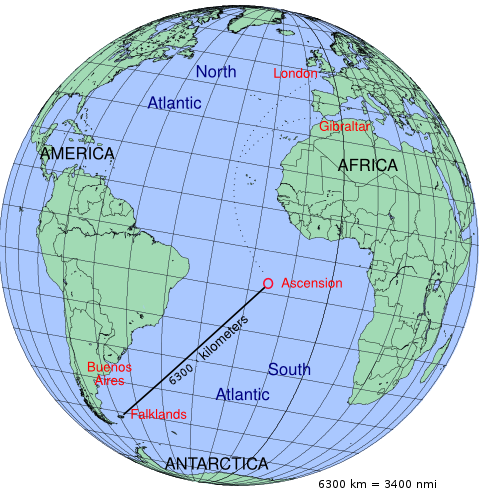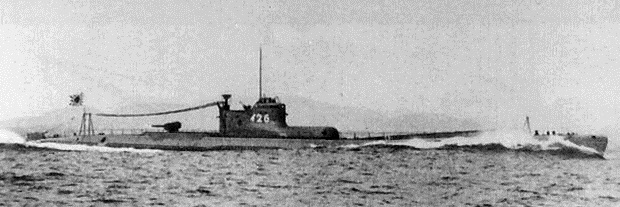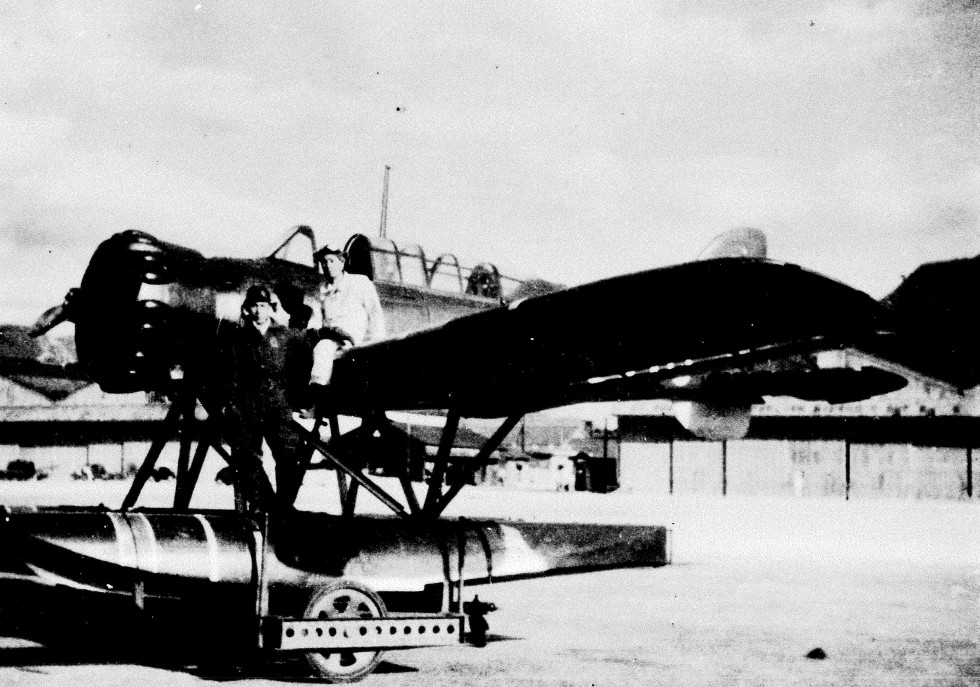|
Fu-Go Balloon Bomb
was an deployed by Japan against the United States during World War II. A hydrogen balloon measuring in diameter, it carried a payload of two incendiary devices plus one anti-personnel bomb (or alternatively one incendiary bomb), and was intended to start large forest fires in the Pacific Northwest. Between November 1944 and April 1945, the Japanese launched about 9,300 balloons from sites on Honshu, of which about 300 were found or observed in the U.S., with some in Canada and Mexico. The balloons traveled on high-altitude and high-speed currents over the Pacific Ocean, today known as the jet stream, and used a sophisticated ballast system to control altitude on their three-day flight. Despite high hopes for the operation, the bombs were largely ineffective due to damp conditions and malfunctions, causing only minor damage and six deaths (from a single civilian incident in Oregon in May 1945). The Fu-Go balloon bomb was the first weapon to possess intercontinental range, ... [...More Info...] [...Related Items...] OR: [Wikipedia] [Google] [Baidu] |
Incendiary Balloon
An incendiary balloon (or balloon bomb) is a balloon inflated with a lighter-than-air gas such as hot air, hydrogen, or helium, that has a bomb, incendiary device, or Molotov cocktail attached. The balloon is carried by the prevailing winds to the target area, where it falls or releases its payload. Historical use Early proposals In 1792, Joseph-Michel Montgolfier proposed using balloons to drop bombs on British forces and ships in Toulon.''Military Aircraft, Origins to 1918: An Illustrated History of Their Impact'' Justin D. Murphy, page 161 In 1807, Denmark attempted to construct a hand-propelled dirigible that would bomb British ships blockading Copenhagen from the air. [...More Info...] [...Related Items...] OR: [Wikipedia] [Google] [Baidu] |
Operation Black Buck
Operations Black Buck 1 to Black Buck 7 were seven extremely long-range ground attack missions conducted during the 1982 Falklands War by Royal Air Force (RAF) Vulcan bombers of the RAF Waddington Wing, comprising aircraft from 44, 50 and 101 Squadrons, against Argentine positions in the Falkland Islands. Five of the missions completed attacks. The objective of the missions was to attack Port Stanley Airport and its associated defences. The raids, at almost and 16 hours for the round trip, were the longest-ranged bombing raids in history at that time. The Operation Black Buck raids were staged from RAF Ascension Island, close to the Equator. The Vulcan was designed for medium-range missions in Europe and lacked the range to fly to the Falklands without refuelling several times. The RAF's tanker planes were mostly converted Handley Page Victor bombers with similar range, so they too had to be refuelled in the air. A total of eleven tankers were required for two Vulcans (o ... [...More Info...] [...Related Items...] OR: [Wikipedia] [Google] [Baidu] |
Washi
is traditional Japanese paper. The term is used to describe paper that uses local fiber, processed by hand and made in the traditional manner. ''Washi'' is made using fibers from the inner bark of the gampi tree, the mitsumata shrub (''Edgeworthia chrysantha''), or the paper mulberry (''kōzo'') bush. As a Japanese craft, it is registered as a UNESCO intangible cultural heritage. ''Washi'' is generally tougher than ordinary paper made from wood pulp, and is used in many traditional arts. Origami, Shodō, and Ukiyo-e were all produced using ''washi''. ''Washi'' was also used to make various everyday goods like clothes, household goods, and toys, as well as vestments and ritual objects for Shinto priests and statues of Buddha. It was even used to make wreaths that were given to winners in the 1998 Winter Paralympics. ''Washi'' is also used to repair historically valuable cultural properties, paintings, and books at museums and libraries around the world, such as the Louvre ... [...More Info...] [...Related Items...] OR: [Wikipedia] [Google] [Baidu] |
Sueki Kusaba
was a blue-gray form of stoneware pottery fired at high temperature, which was produced in Japan and southern Korea during the Kofun, Nara, and Heian periods of Japanese history. It was initially used for funerary and ritual objects, and originated from Korea to Kyūshū. Although the roots of Sueki reach back to ancient China, its direct precursor is the grayware of the Three Kingdoms of Korea. History The term ''Sue'' was coined in the 1930s by the archaeologist Shuichi Goto ( :ja:後藤守一) from a reference to vessels mentioned in the 8th century Japanese classical poetry anthology ''Man'yōshū''. Previous to this, the terms or ''Chosen doki'' were in more common use. Sue pottery is believed to have originated in the 5th or 6th century in the Kaya region of southern Korea, and was brought to Japan by immigrant craftsmen. It was contemporary with the native Japanese Haji pottery, which was more porous and reddish in color. Sue ware was made from coils of clay, beaten ... [...More Info...] [...Related Items...] OR: [Wikipedia] [Google] [Baidu] |
Siskiyou National Forest
Siskiyou may refer to: *Siskiyou Mountains, a mountain range in northern California and southern Oregon *Siskiyou National Forest, in Oregon and California *Siskiyou County, California *Siskiyou Trail, an old Native American and pioneer trail connecting Oregon and California *Siskiyou Summit, a mountain pass (4,037 ft/1,230 m) on Interstate 5 in southern Oregon *Siskiyou Mountains salamander *Siskiyou (newspaper), a student-run newspaper at Southern Oregon University in Ashland, Oregon. *Siskiyou (band), a Canadian indie folk band. {{disambig ... [...More Info...] [...Related Items...] OR: [Wikipedia] [Google] [Baidu] |
Nobuo Fujita
(1911 – 30 September 1997) was a Japanese naval aviator and warrant flying officer of the Imperial Japanese Navy who flew a floatplane from the long-range submarine aircraft carrier and conducted the Lookout Air Raids in southern Oregon on September 9, 1942, making him the only Axis pilot during World War II to aerial bomb the contiguous United States. Using incendiary bombs, his mission was to start massive forest fires in the Pacific Northwest near the city of Brookings, Oregon with the objective of drawing the U.S. military's resources away from the Pacific Theater. The strategy was also later used in the Japanese fire balloon campaign. Early life and military career Nobuo Fujita joined the Imperial Japanese Navy in 1932 and became a pilot in 1933. Fujita also had a younger brother who was killed in the war. Pearl Harbor and U.S. West Coast Fujita was on board during the attack on Pearl Harbor, where the ''I-25'' and three other submarines patrolled a line north ... [...More Info...] [...Related Items...] OR: [Wikipedia] [Google] [Baidu] |
Yokosuka E14Y
The Yokosuka E14Y ( Allied reporting name Glen) was an Imperial Japanese Navy reconnaissance seaplane transported aboard and launched from Japanese submarine aircraft carriers such as the during World War II. The Japanese Navy designation was "Type 0 Small Reconnaissance Seaplane" (零式小型水上偵察機). Design and development Operational history The E14Y was used for several Japanese reconnaissance missions during the Pacific War. On 26 February 1942 the Japanese submarine ''I-25'', under the command of Captain Akiji Tagami, was off the northern tip of King Island in Bass Strait off the coast of Victoria, Australia, when an E14Y was launched on a reconnaissance flight over the Port of Melbourne. The pilot and observer/gunner were in the air for three hours, during which time they successfully flew over Port Phillip Bay and observed the ships at anchor off Melbourne before returning to land on its floats beside the submarine, where it was winched aboard and disassem ... [...More Info...] [...Related Items...] OR: [Wikipedia] [Google] [Baidu] |
Lookout Air Raid
The Lookout Air Raids were minor but historic Japanese air raids that occurred in the mountains of Oregon, several miles outside Brookings during World War II. On September 9, 1942, a Japanese Yokosuka E14Y ''Glen'' floatplane, launched from a Japanese submarine, dropped two incendiary bombs with the intention of starting a forest fire. However, with the efforts of a patrol of fire lookouts and weather conditions not amenable to a fire, the damage done by the attack was minor. The attack was the first time the contiguous United States was bombed by an enemy aircraft. It was also the second time the continental United States was attacked by enemy aircraft during World War II, the first being the bombing of Dutch Harbor three months earlier. Lookout Air Raids On Wednesday morning, September 9, 1942, the submarine ''I-25'', under the command of Lieutenant Commander Akiji Tagami, surfaced west of Cape Blanco. The submarine launched a "Glen" Yokosuka E14Y floatplane, fl ... [...More Info...] [...Related Items...] OR: [Wikipedia] [Google] [Baidu] |
Seaplane
A seaplane is a powered fixed-wing aircraft capable of takeoff, taking off and water landing, landing (alighting) on water.Gunston, "The Cambridge Aerospace Dictionary", 2009. Seaplanes are usually divided into two categories based on their technological characteristics: floatplanes and flying boats; the latter are generally far larger and can carry far more. Seaplanes that can also take off and land on airfields are in a subclass called amphibious aircraft, or amphibians. Seaplanes were sometimes called ''hydroplanes'', but currently this term applies instead to Hydroplane (boat), motor-powered watercraft that use the technique of Planing (boat), hydrodynamic lift to skim the surface of water when running at speed. The use of seaplanes gradually tapered off after World War II, partially because of the investments in airports during the war but mainly because landplanes were less constrained by weather conditions that could result in sea states being too high to operate seaplan ... [...More Info...] [...Related Items...] OR: [Wikipedia] [Google] [Baidu] |
Imperial General Headquarters
The was part of the Supreme War Council and was established in 1893 to coordinate efforts between the Imperial Japanese Army and Imperial Japanese Navy during wartime. In terms of function, it was approximately equivalent to the United States Joint Chiefs of Staff and the British Chiefs of Staff Committee. History The Imperial General Headquarters was established by Imperial Decree 52 on 22 May 1893 under the auspices of creating a central command for both the Imperial Japanese Army General Staff Office and the Imperial Japanese Navy General Staff. The Emperor of Japan who was defined as both Head of State and the Generalissimo of the Imperial Japanese Armed Forces according to the Meiji Constitution of 1889 to 1945, was the head of the Imperial General Headquarters, and was assisted by staff appointed from the Imperial Japanese Army and Imperial Japanese Navy. The Imperial General Staff Headquarters was completely independent of the civilian government of the Empire of Japan ... [...More Info...] [...Related Items...] OR: [Wikipedia] [Google] [Baidu] |
Doolittle Raid
The Doolittle Raid, also known as the Tokyo Raid, was an air raid on 18 April 1942 by the United States on the Japanese capital Tokyo and other places on Honshu during World War II. It was the first American air operation to strike the Japanese archipelago. Although the raid caused comparatively minor damage, it demonstrated that the Japanese mainland was vulnerable to American air attacks. It served as an initial retaliation for the 7 December 1941 attack on Pearl Harbor, and provided an important boost to American morale. The raid was planned by, led by, and named after Lieutenant Colonel James Doolittle (later a Lieutenant General in the US Army Air Forces and the US Air Force Reserve). Under the final plan, 16 B-25B Mitchell medium bombers, each with a crew of five, were launched from the US Navy aircraft carrier , in the Pacific Ocean, off Japan. There were no fighter escorts. After bombing the military and industrial targets, the crews were to continue westward to lan ... [...More Info...] [...Related Items...] OR: [Wikipedia] [Google] [Baidu] |
Code Name
A code name, call sign or cryptonym is a code word or name used, sometimes clandestinely, to refer to another name, word, project, or person. Code names are often used for military purposes, or in espionage. They may also be used in industrial counter-espionage to protect secret projects and the like from business rivals, or to give names to projects whose marketing name has not yet been determined. Another reason for the use of names and phrases in the military is that they transmit with a lower level of cumulative errors over a walkie-talkie or radio link than actual names. Military origins During World War I, names common to the Allies referring to nations, cities, geographical features, military units, military operations, diplomatic meetings, places, and individual persons were agreed upon, adapting pre-war naming procedures in use by the governments concerned. In the British case names were administered and controlled by the Inter Services Security Board (ISSB) staffed b ... [...More Info...] [...Related Items...] OR: [Wikipedia] [Google] [Baidu] |
.jpg)



_MET_2015_300_259_Burke_website.jpg)



